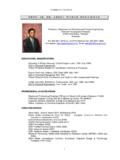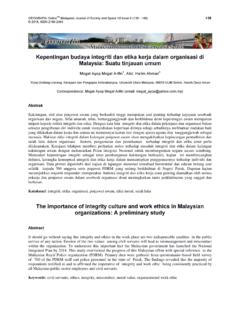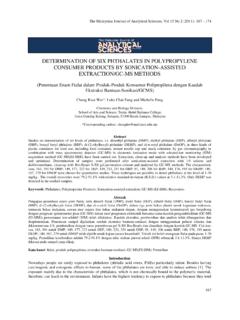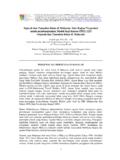Transcription of PHYTOCHEMICAL SCREENING, TOTAL FLAVONOID AND …
1 Malaysian Journal of Analytical Sciences, Vol 20 No 5 (2016): 1181 - 1190 DOI: 1181 MALAYSIAN JOURNAL OF ANALYTICAL SCIENCES Published by The Malaysian Analytical Sciences Society PHYTOCHEMICAL SCREENING, TOTAL FLAVONOID AND PHENOLIC CONTENT ASSAYS OF VARIOUS SOLVENT EXTRACTS OF TEPAL OF Musa paradisiaca (Penyaringan Fitokimia, Jumlah Asai Kandungan FLAVONOID dan Fenolik Pelbagai Ekstrak Pelarut Tepal Musa paradisiaca) Mahadeva Rao1*, Muhammad Abdurrazak1, Khamsah Suryati Mohd2 1 Faculty of Medicine, Universiti Sultan Zainal Abidin, Kota Campus, 20400 Kuala Terenganu, Terenganu, Malaysia 2 Faculty of Bioresources and Food Industry, Universiti Sultan Zainal Abidin, Tembila Campus, 22200 Besut, Terenganu, Malaysia *Corresponding author: Received: 14 April 2015.
2 Accepted: 3 August 2016 Abstract The objective of this research is to conduct the preliminary PHYTOCHEMICAL screening, TOTAL FLAVONOID and phenolic contents assays of various solvent extracts of tepal of Musa paradisiaca. PHYTOCHEMICAL screening was carried out according to the method of Trease and Evans, TOTAL FLAVONOID content was measured by the aluminium chloride colorimetric assay and TOTAL phenolic content was estimated spectrophotometrically by Folin-Ciocalteau method. - Preliminary PHYTOCHEMICAL screening reveals the presence of phenolics, flavonoids, alkaloids, tannins, terpenoids in all the three different extracts (methanolic, ethanolic and aqueous).
3 Tepal methanolic extract has the richest content of both phenolics and flavonoids ( mg GAE/g and mg QE/g) respectively, and aqueous extract was the least ( mg GAE/g and mg QE/g). All the extracts were not significantly different with one another (p > ). It can be hypothesised that the high contents of phenolic compounds of tepals of Musa paradisiaca indicated that these compounds contribute to the antioxidant activity and can be regarded as promising plant species for natural sources of radical scavenging activity with potential value for treatment of many life threatening diseases.
4 Keywords: PHYTOCHEMICAL , FLAVONOID , phenolics, Musa paradisiaca Abstrak Objektif kajian ini adalah untuk menjalankan pemeriksaan awal ke atas ketulenan fitokimia, jumlah kandungan fenolik FLAVONOID dan pelbagai ekstrak pelarut tepal Musa paradisiaca. Penyaringan fitokimia telah dilaksanakan mengikut kaedah Trease dan Evans, dimana jumlah kandungan FLAVONOID diukur oleh ujian kalorimetrik aluminium klorida dan jumlah kandungan fenolik dianggarkan secara spektrofotometer dengan kaedah Folin-Ciocalteau. Penyaringan awal fitokimia menunjukkan kehadiran fenolik, FLAVONOID , alkaloid, tannin dan terpenoid dalam ketiga-tiga ekstrak yang berbeza (metanol, etanol dan akueus).
5 Ekstrak metanol Tepal mempunyai kandungan yang paling tinggi di antara kedua-dua fenolik dan FLAVONOID iaitu sebanyak mg GAE/g dan mg QE/g, manakala ekstrak akueus adalah mempunyai kandungan terendah iaitu sebanyak mg GAE/g dan 0,164 mg QE/g. Semua ekstrak tidak berbeza secara ketara antara satu sama lain (p > ). Oleh itu, hipotesis yang boleh dibuat adalah kandungan yang tinggi sebatian fenolik daripada tepal Musa paradisiaca menyumbang kepada aktiviti antioksidan dan boleh dianggap sebagai spesies tumbuhan yang berpotensi untuk merawat pelbagai penyakit yang mengancam nyawa.
6 Kata kunci: fitokimia, FLAVONOID , fenolik, Musa paradisiaca ISSN 1394 - 2506 Rao et al: PHYTOCHEMICAL SCREENING, TOTAL FLAVONOID AND PHENOLIC CONTENT ASSAYS OF VARIOUS SOLVENT EXTRACTS OF TEPAL OF Musa paradisiaca 1182 Introduction Consumption of medicinal herbs protects and heals a number of ailments and they have been the principal treatment therapy in prehistoric times until the discovery of synthetic drugs in the nineteenth century [1]. This exploration of biologically active natural products has played an important role in finding new chemical entities (NCEs), for example, approximately 28% of NCEs between 1981and 2002 were natural products or natural product-derived [2].
7 Health benefits has been derived from bioactive compounds that are commonly found in edible plant parts such as fruits, vegetables, flowers, leaves and have been shown to confer protection against various ailments [3]. Interestingly, many of them are known to contain large amounts of phenolic antioxidants [4]. Phytchemicals have become an intense focus of research interest because of their perceived beneficial effects for health, including anticarcinogenic, antiatherogenic, antiulcer, anti-thrombotic, anti-inflammatory, immunemodulating, antimicrobial, varodialatory, and analgesic effects.
8 Therefore, the search for exploitation of natural antioxidants , especially of plant origin, has greatly increased in recent years [1]. For example, chard extract (Beta vulgaris L. var. cicla) has been used as a hypoglycaemic agent by diabetic mellitus (DM) patients in Turkey [5] and it has been documented that the number of similarly various phytoconstituent such as epicatechin, rutin, quercetin, nymphayol and FLAVONOID extracts from Pterocarpus marsupium have shown to possess -cells regeneration capacity [6]. Flavonoids represent the most common and widely distributed group of plant phenolics [7] and are abundant in foods; quercetin and rutin are the flavonoids most abundantly consumed [8].
9 Musa paradisiaca is one of the well-known plants of the Musaeae family that have been used in traditional medicine since hundred years to alleviate various diseases and health problems. Active constituent presence in the plants materials might be responsible to the beneficial of human health. The most important of these bioactive compounds of plants are alkaloids, flavonoids, tannins and phenolic compounds [9]. Ethnomedicinal survey around the world revealed that the flowers of Musa spp. have been used to treat many illnesses.
10 Its flowers have been traditionally used to alleviate menorrhagia, dysentery, diabetes mellitus [10], heart pain, diarrhea, stomach cramps and infantile malnutrition [11]. It was reported that the extracts of the flowers possess medicinal properties for illness such as diabetes mellitus, anaemia [12] and malaria [13]. Phenolics are the largest group of phytochemicals that account for most of the antioxidant activity in plants or plant products [14]. More than 4000 polyphenols (flavonoids, monophenols and poly phenols) are found in vascular plants.









